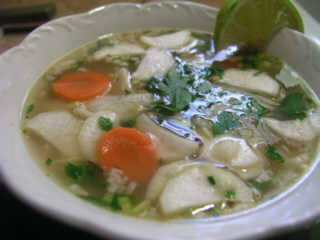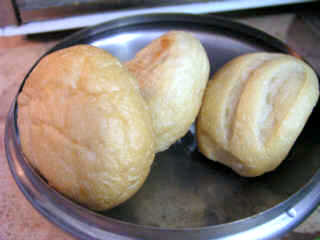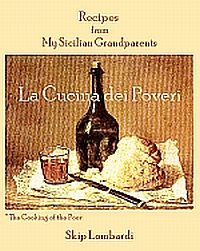Living on $42.00 per Week-Day 4
July 19th, 2007Total food stamp funds remaining: $17.87.
Lunch Wednesday:

After yielding two meals, our weekend chicken didn’t owe us a thing. Nonetheless, we took the remaining bones (approx.. 6 oz. including the bits of meat clinging to them) and made our version of “stone soup *.”
Placing the bones in a 3-quart sauce pan with approx. 3 cups of water, we simmered them for 15 minutes then strained the liquid, reserving the bones. When the bones were cool enough to handle, we stripped them of their meat. Suprisingly, we had nearly 3/4 of a cup.
We brought the chicken broth back to a boil and added 1/4 cup of medium-grain white rice, some minced ginger root, garlic, and 2 kaffir lime leaves **. Having reduced the heat, we let the covered pot simmer for 15 min., until the rice was done.
Sunday’s pre-cooked carrots were thinly sliced and put into the pot along with a rib of celery and a scallion (both minced). In the spirit of “Archeology begins at home. Excavate your own fridge first,” we also tossed in half-moon slices from a piece of daikon found lurking on the bottom of the vegetable bin.
A dash of hot sauce, salt & freshly ground pepper, and a few snips of flat-leaf Italian parsley (because we’d forgotten to buy cilantro) finished this lively, vaguely Thai-tasting soup. It gave us 2 servings each.
Stone Soup provides a great illustration of how we—and anyone else—can make a tight food budget work. Leftovers aside, imagination and a little effort are the crucial ingredients in any satisfying dish.

This meal marked the last of our day-old rolls from BJ’s. They’ve served us well. And with our little trick with the kitchen faucet and the toaster oven, they’ve provided a satisfying accompaniment to many of the casual meals we’ve been enjoying this week. And at $2.00 for eighteen rolls, they rank along side our produce supply as one of the best bargains we’ve found for this experiment.
* Stone Soup: The old parable of how those with little, gain much if they share what they do have.
** This may seem a bit over-the-top on a food-stamp budget, but we’ll explain: we’d bought the kaffir lime leaves from our local Vietnamese grocer before Christmas last year. For $1.00 we came home with a bag containing approximately 70 of these beauties. They keep well in the freezer, and we’ve simply been dipping into the bag as recipes warrant. Though we also have lemon grass growing in our back yard, we decided against using it for this recipe in the interest of time and simplicity.
Supper Wednesday:
Midway through our challenge, the Sicilian half of this duo was suffering from pasta withdrawl. What better way to assuage the malady than to use up 3/4 cup of ricotta left from last week? Because we also had some Red Barn eggplant, and because it was already after 8 PM, and because we often turn to other sources for inspiration, we Googled “ricotta + eggplant + pasta” and found ourselves on the Food & Wine website. A recipe for pasta with eggplant, ricotta, and tomatoes was right there. Did we follow it? Not really, but sometimes all one needs is an idea.
Eggplants have earned a bad reputation for being oil sponges. Cooks of all stripes have long tried to devise techniques to keep their eggplants from absorbing all that precious olive oil. Among alternatives to frying is merely brushing eggplant slices with oil and either baking them or putting them under the oven broiler.
We have two oil-free techniques, each of which flies in the face of centuries of Italian cookery. One, is to use our George Foreman outdoor grill. It gets just hot enough to cook the eggplant slices through without burning them. We can season them later when we assemble a dish like eggplant parmigiana or mousakka
The other prep method is more radical, more counter-Italian than even an electric grill: we steam our eggplant. This requires total attention, because eggplant can quickly go from firm to mushy. But steaming uses no oil and takes approximately 3 minutes.
If steaming eggplant is radical, our method for cooking pasta will send Italians, Italophiles, and foodies in general into paroxysms. Depending on the recipe, whenever we can, we use our trusty Pasta Perfect, *** as seen on TV. (That’s according to the blurbs on the box. We don’t have cable; for that matter, we don’t even own a TV.)
Before moving to Sarasota, we bought our Pasta Perfect as a joke at one of those “job lot” stores in Connecticut. However, it turned out the joke was on us. It works…mostly. We can cook spaghetti or linguine to the al dente state. But certain shaped pastas—like penne, rigatoni, or shells—will cook only so far and no further, no matter how long they sit in steaming water. That’s okay because the only time we use Pasta Perfect is when we plan to finish cooking our pasta in a sauce.
But the benefits of our Pasta Perfect outweigh the laughs. We need boil only two quarts of water rather than six; once the water comes to a boil, we can turn off the stove, saving energy. We don’t need a colander because the top of our Pasta Perfect is perforated for easy drainage. Finally, when we’re done, clean-up is not a pot and a colander, but just the single plastic tube of Pasta Perfect.
Alas, delicious as this recipe may be, it turned out to be brutta ma buona, that is, not particularly photogenic.
Pasta with Eggplant & Ricotta
Ingredients:
1 Small eggplant, approximately 1/2 Lb., cut into 3/4 in. cubes
Olive Oil
2 Cloves garlic, sliced
1 Small onion, diced
1 tsp. Crushed red pepper flakes
4 – 5 Plum tomatoes, coarsely chopped
3/4 Cup whole milk ricotta
1/4 Cup flat-leaf Italian parsley, finely chopped
Salt & freshly ground black pepper
Parmigiano cheese
1/2 Lb. Short, tubular pasta (We used campanelle. Substitute penne, rigatoni, or mostaccioli if you prefer)
Preparation:
Bring about 1 in. of water to a boil in a three-quart saucepan. Add 1 Tbs. salt, then the eggplant. Reduce heat to medium-low and steam the eggplant for approximately three minutes, or until it’s slightly translucent and tender. Drain in a colander and reserve.
Heat a large saute pan over medium-high heat. Add just enough olive oil to film the bottom of the pan, then add the garlic, onion and red pepper flakes. Lower the heat slightly, and saute the mixture until the onion is wilted; three or four minutes.
Add the tomatoes, and cook until they soften and begin to render some of their juices. Add the eggplant, and cook to heat through. Taste for seasoning and add salt & pepper as necessary.
Reduce heat to low, and stir in the ricotta. Maintain on low heat while the pasta cooks.
Cook the pasta in your traditional way, according to the manufacturer’s recommendations. When the pasta is al dente, drain and add it with the parsley to the sauce. Raise the heat slightly and cook, stirring gently to keep it from sticking, for two or three minutes until the pasta is done, and has absorbed some of the sauce.
Pour the pasta into a large bowl, garnish with freshly grated Parmigiano, and serve family-style.
Ordinarily, this would be sufficient for four as a pasta course. Since it was our whole dinner, this served two abundantly.
*** We agree, Pasta Perfect is so strange, it deserves a blog post of its own. We’ll put that on our to-do list for the future when we’ve finished writing about our Food Stamp Challenge experiences.
Links to the other posts in our series:
Living on $42.00 Per Week—the Challenge
Living on $42.00 Per Week—Day 1
Living on $42.00 Per Week—Day 2
Living on $42.00 Per Week—Day 3
Living on $42.00 Per Week—Day 5
Living on $42.00 Per Week—Day 6
Living on $42.00 Per Week—Day 7
Living on $42.00 Per Week—Summary
Living on $42.00 Per Week—Redux



